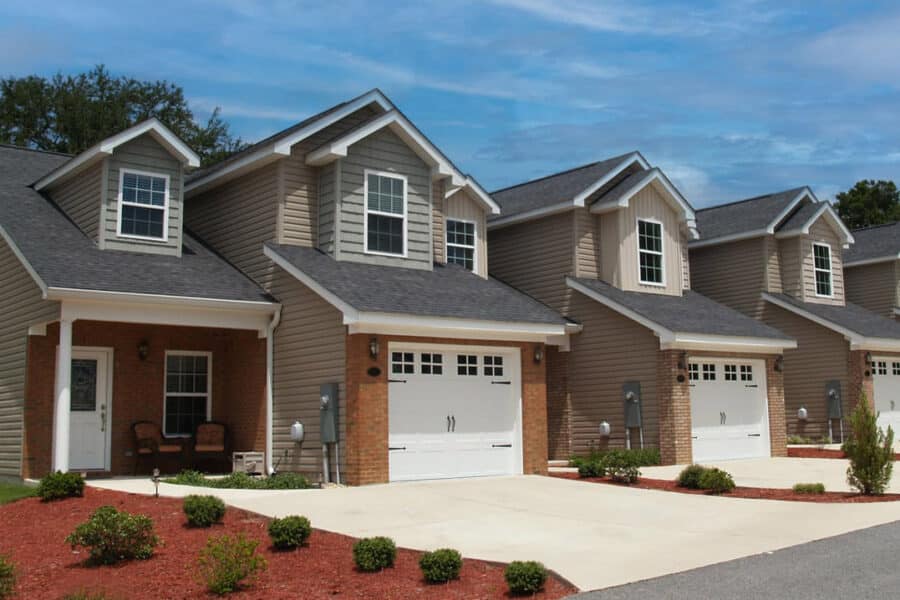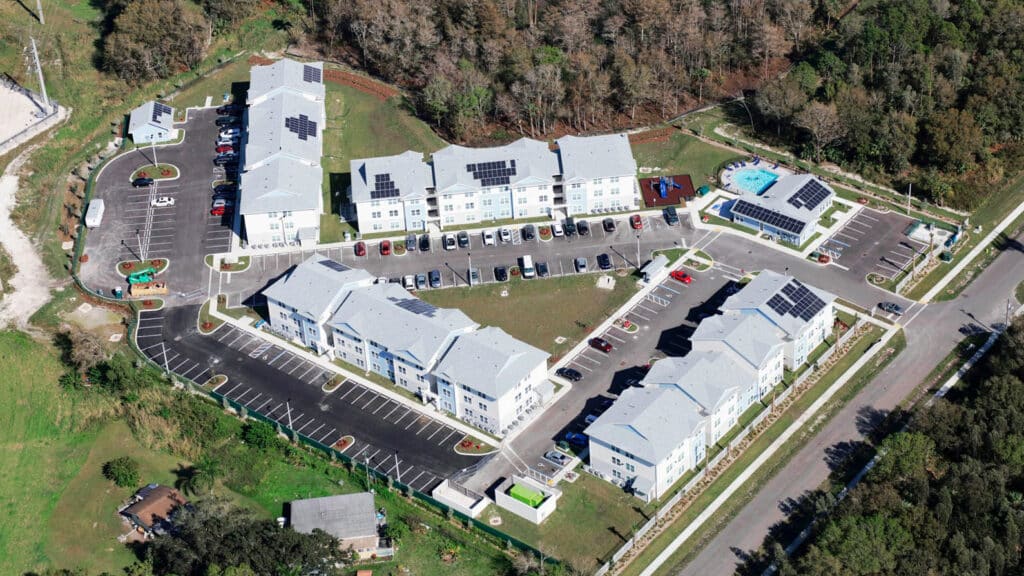
Narrow track of housing affordability
A simplified measure of housing affordability is the ratio of median household (HH) income over income needed to own a median-valued home. This is a gauge of broad-based affordability that can help determine if a market is balanced. Using the input choices shown in Figure 1 yields a current index of 1.07 for Florida indicating that the median-income family of four can afford just a bit more than the median-priced home. Does this mean “all is good?”
Figure 1 – Key metrics for affordable housing
| Metrics | Cost |
|---|---|
| Median sale price (March 2024) | $368,333 |
| 30-year primary mortgage interest rate (May 2024) | 6.94% |
| Monthly payment for 80% loan * | $1,949 |
| HUD income requirement ** | $77,943 |
| Census ACS 2022 family of four median income | $83,410 |
| Affordability index | 1.07 |
Sources: Zillow, Federal Home Loan Mortgage Corp., Department of Housing and Urban Development, U.S. Census American Community Survey, UF Bergstrom Real Estate Center
This statistic only describes a single point (the median crossover) yielding no information about the HHs that struggle to afford housing. Most of the programs dedicated to housing affordability are focused on below-median income. The nation’s largest program dedicated to financing affordable housing is the federal low-income housing tax credits (LIHTC) initiative. Congress created the LIHTC program as a part of the Tax Reform Act of 1986. The program aims to incentivize private investment into affordable housing creation by offering tax credits to developers who commit to building rent-controlled units. By using these credits, developers commit to maintain restricted rents for 30 years or more. During this period, units must be affordable to HHs earning up to 80%, 60%, 50%, or 30% of area median income (AMI), depending on the project’s financing structure. The program helps finance roughly 85% to 90% of U.S. affordable rental projects, according to Shelterforce, a news organization that covers affordable housing.
The number of rent-managed units in Florida was 310,855 receiving support from the various programs shown in Figure 2, according to the UF Shimberg Center for Housing Studies. The sum of units in the chart is more than the total because many affordable projects receive support from multiple programs. The Florida Housing Finance Corp. (FHFC) supports the most affordable units in the state through the federal LIHTC program and state programs, such as State Apartment Incentive Loan (SAIL) and HOME Investment Partnerships. The Shimberg Center’s Florida Housing Data Clearinghouse identifies just under 220,000 of these units as LIHTC program units.
Source: UF Shimberg Center for Housing Studies
To understand the demand for these units, consider the number of HHs earning less than the median income. We distinguish between family and non-family HHs because there are stark differences in their characteristics that impact a program’s ability to meet housing needs. Florida has 8.8 million HHs split between 5.7 million families and 3.1 million non-families, according to the U.S. Census Bureau. The number of Florida families within each income bracket is given in Figure 3. From Figure 1, we know that the state median income for a four-member family is $83,410. The 50% AMI program limit is $40,900, established by HUD using several factors related to location and family size. Interpolating between numbers in Figure 3, 1.18 million, or 20.8% of all families are below the 50% AMI threshold. These are families of all sizes but sets an upper limit for four-members families.
Figure 3 – Florida households by income
| Annual income range | No. of HHs | % of HHs |
|---|---|---|
| 0 – 9999 | 198,954 | 3.5% |
| 10,000 -14,999 | 96,635 | 1.7% |
| 15,000 – 24,999 | 284,220 | 5.0% |
| 25,000 – 34,999 | 363,802 | 6.4% |
| 35,000 – 49,999 | 608,231 | 10.7% |
| 50,000 – 74,999 | 993,349 | 17.5% |
| 75,000 – 99,999 | 829,922 | 14.6% |
| 100,000 – 149,999 | 1,084,299 | 19.1% |
| 150,000 – 199,999 | 532,912 | 9.4% |
| 200,000 + | 692,076 | 12.2% |
| Total | 5,684,399 |
Not all eligible families qualify to rent the unit specified for their family size. In addition to the eligibility ceiling set by HUD, investors set a credit floor to the income of prospective tenants. The most typical county in the state is Escambia and a two-bedroom unit in its 50% AMI program rents for $921 per month. Most operators require a family’s income to be at least 2.5 times the rent to qualify. In this case, families with income between $27,630 and $40,900 will be both eligible and qualified. Thus, overall demand for affordable units is high at more than 1 million HHs but only about 400,000 are suitable for the unit described. Acknowledging the gross generalization, it could be suggested that LIHTC is serving 220,000 of the 400,000 family HHs for which it was designed.
Program structure
Funding LIHTC projects comes from the owner (collectively the developer and investor group) and federal and local taxpayers. Some development costs are excluded from the tax credit calculation such as land and specific soft costs. These costs are borne directly by the owner. The bulk of the building cost is paid by the proceeds from tax credits – which amounts to 35% to 90% of the eligible costs depending on the program – either 4% credits or 9% credits. This portion is carried by federal taxpayers in the form of foregone future tax collections by the IRS. Debt financing typically comes from local programs that offer 0% to 1% loan financing for affordable development. The spread between this discounted interest rate and the market rate is paid by local taxpayers. The owner funds the remaining costs. In exchange for the financial contribution and an agreement to operate the property under rent restrictions, the owner receives the allowable rent collections plus the residual value of the property once a restricted period ends.

LIHTC is delivered through two programs, 4% or 9%. The number represents the portion of eligible costs awarded to developers per year for the following 10 years. This stream of future tax abatements is sold to produce the equity used to fund the project. Both programs extend federal tax credits to developers, but the allocation process is very different. 9% credits are funded by a formulaic allotment from the IRS that is distributed to state agencies for award to developers who win a bidding process based on the project’s community impact. These credits become approximately a 75% equity component of the development capital stack. 4% credits are not taken from this allotment but rather are awarded automatically when a developer receives tax-exempt bond financing for at least 50% of eligible costs. These credits become approximately a 30% equity component. Angel Arroyo, a principal of AGPM and Banyan Realty Advisors, points out that “developments using 9% credits are very limited as these credits are highly competitive. As a result, the next option is 4% credits but current construction costs are making these projects less financially feasible.”
Median incomes in Florida range from $47,800 in Hendry County (where monthly two-bedroom, 50% restricted rents are $722) to $100,700 in Collier County (where the same unit rents for $1,123), according to HUD. Each qualifying property must focus on its own income requirements and charge strictly defined rents. Owners, who collect the rent, will seek 9% credits in locations with high AMI. This may or may not be the most effective delivery of affordable housing, but it yields the best return to owners. FHFC is responsible for directing these credits to the most needed areas based on proposed projects. 4% credits, although not specifically limited by the IRS, are controlled by the ability to obtain tax-exempt bond financing.
Growth in the number of units
The U.S. Department of Treasury awarded Florida $72.4 million in credits in 2024, according to Novogradac, a professional services organization that specializes in affordable housing. The funds will be used to support the development of new affordable units in the state. Depending on specific submissions to FHFC and projects awarded credits, this amount will fund about a thousand new affordable units in Florida this year but not the several thousand that are needed. These additional units in the affordable portfolio are offset by the units built 30 years ago that see their restrictions expire. Thus, the number of affordable units could grow or shrink in any given year depending on the number built and the number expiring as shown in Figure 4.
Source: UF Shimberg Center for Housing Studies – Florida Housing Data Clearinghouse
Over the next five years, 46 affordable housing properties across the state of Florida will see their compliance periods come to an end. If all these properties adjust to charging market rents, the state stands to lose over 6,600 affordable units. The number of expiring units will increase dramatically over the following five years, as observed in Figure 4. There are a few cases where 9% credits expired and 4% credits were subsequently issued for renovation, keeping the units in the LIHTC program. Perhaps this sequence will continue to retain affordability. Units built under the 9% program are relatively consistent because the funding level grows gradually each year. Most of the volatility in the funding and expirations shown in Figure 4 is due to changes in the 4% program. It seems that unit development spikes when interest rates are low. This may create a challenging market if rates are high when the number of expirations increase.

Developing housing that is affordable to HHs with income well below the median is a challenge, especially when it is important to locate that housing in highly developed and desirable areas. LIHTC is a complex program structured to allow states to direct federal funds to the projects that best meet their housing needs. Even so, new projects typically need additional support from other programs primarily in the form of debt. Despite these existing programs, affordable supply is unable to keep up with growing demand, and the phase where properties’ restrictions expire is just beginning. This story provides only a summary of the overall need for affordable housing and how the LIHTC program works. The more we know, the better our chances of improving effectiveness and developing complementary programs.
Author: Clayton Gardner is a University of Florida Nathan S. Collier Master of Science in Real Estate graduate.
Related stories

For the media
Looking for an expert or have an inquiry?
Submit your news
Contact us
Follow us on social
@ufwarrington | #BusinessGators

